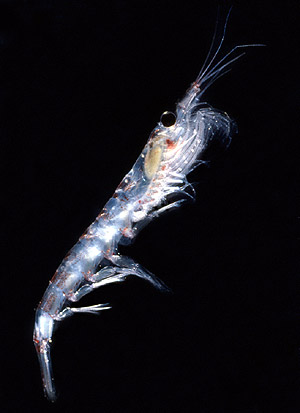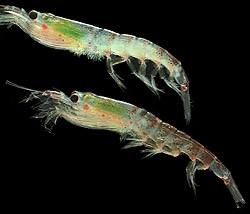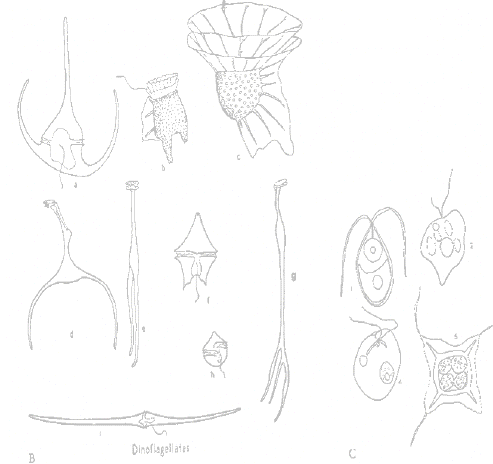 More than anything else, krill are the engine that powers the Antarctic ecosystem.
More than anything else, krill are the engine that powers the Antarctic ecosystem.They are a small semi-transparent crustacean like a shrimp, about 4-5 cm (2") in length when fully grown, they can live for up to 6 years which is quite remarkable considering the wide variety of animals that feed on them in huge quantities. Krill belong to the animals that make up the zooplankton. The "zoo" means that they are animals, the "plankton" means that they float in the upper reaches of the water column and are at the mercy of the ocean currents, being able to change their position in the water column, but not able to swim against the current or migrate in the normal sense.
Krill feed on microscopic phytoplankton ("phyto" - plant) that are extremely abundant in Antarctic waters due to the great upwellings of deep waters at the Antarctic convergence. These upwellings bring with them great amounts of dissolved nutrients, especially nitrate and phosphate that fertilize the microscopic but hugely abundant phytoplankton in the same way that a farmer puts fertiliser on the fields. Add to this the 24 hour intense sunlight of the summer months and the scene is set for a super-abundance of life.
Krill are unusual in that they are so super-abundant and large when compared to other phytoplankton feeders in other oceans. This means that many large animals such as seals, penguins, whales and myriad birds are able to tap the food chain close to the production of the phytoplankton before energy is lost, so the Antarctic supports a large population of large animals.
Krill rise and fall in the water column depending on the time of day, they drift around in swarms that are so large it difficult to imagine, so they are either not in a particular area at all or are present in unimaginably huge quantities. Swarms estimated at containing 2 million tons of krill spreading over more than 450 square kilometres have been observed. This is the equivalent of 28.5 million human beings, 4 times the population of Greater London or approximately the entire population of Canada, averaging 70kg each, in area a third that of Greater London. The krill population of the world has been estimated at outweighing the human population of the world
There is a very complex ecology that has arisen involving krill and krill predators, with different species of predator feeding at different times of year at different depths and on different sizes and therefore age groups of krill. Despite the apparent ever present seemingly overwhelming presence of predators, krill can manage a lifespan of up to seven years.
There have been attempts to catch krill commercially and great factory ships have been sent down to the Antarctic by some nations to catch and can krill quickly. Fortunately for the krill and the Antarctic ecosystem , krill go off very quickly after being caught, the Antarctic is a long way away and consumer interest remains fairly low (krill aren't very nice for people to eat!). Krill is harvested by the Japanese (and a small amount by Russia) at around 100,000 tonnes per annum.
The most effective way of catching krill so far devised are the great baleen plates of baleen whales, such as Blues, Rights, and Fin whales. These baleen plates made of the original "whalebone" (actually keratin, the same stuff that hair, fingernails and rhinoceros horns are made from) hanging in two rows from the roof of the baleen whales mouth. The whale skull has an upper jaw that is a long straight rod sticking straight out from the "brain case" up to 10-12ft (3-3.5m) or more long. The baleen plates make a sort of triangular "tent" the floor of the tent is the lower jaw and the large tongue is inside (the tongue of a large blue whale can weigh as much as an adult bull elephant). The baleen whale takes a large mouthful of sea water and krill with its mouth open, it closes its mouth and then forces excess water out with its tongue. The baleen plates are filters that let out water and small plankton but retain the larger plankton such as krill which are then swallowed.
Different whales feed at different depths and their filters are arranged slightly differently so they do not all compete for the same sized krill.
One way of feeding by some of the larger baleen whales is "bubble netting". The whale, or sometimes two working in a pair, dive down below a dispersed krill swarm. They then swim upwards in a spiral blowing air bubbles as they go. The bubbles cause the krill to panic and swim inwards so concentrating them into a smaller space. The whale then swims directly up through the middle with mouth wide open taking in a huge mouthful of krill and water that the baleen plates then filter.
Krill shortages
 Recent studies (November 2004) have shown that stocks of krill in Antarctica have declined dramatically in recent years. The reason for this is likely to be a fall in the amount of sea ice in the winter months particularly in the Antarctic Peninsula region.
Recent studies (November 2004) have shown that stocks of krill in Antarctica have declined dramatically in recent years. The reason for this is likely to be a fall in the amount of sea ice in the winter months particularly in the Antarctic Peninsula region.Krill numbers may have dropped by as much as 80% since the 1970's - so today's stocks are a mere 1/5th of what they were only 30 years ago. The decline in krill may in turn account for the decline in the numbers of some penguin species.
Dr Angus Atkinson from British Antarctic Survey, says: "This is the first time that we have understood the full scale of this decline. Krill feed on the algae found under the surface of the sea-ice, which acts as a kind of 'nursery'.
The Antarctic Peninsula, a key breeding ground for the krill, is one of the places in the world where there has been the greatest rise in temperatures due to global warming. This region has warmed by 2.5°C in the last 50 years (much more than the mean global rate), with a striking consequential decrease in winter sea-ice cover.
"We don't fully understand how the loss of sea-ice here is connected to the warming, but we believe that it could be behind the decline in krill."
There are commercial implications as well as scientific ones. The Southern Ocean is a valuable fisheries resource, many of the species caught feed on krill. Thousands of tourists are also attracted to Antarctica to enjoy the spectacular wildlife, most of which feed on krill.
There has been previous speculation that krill stocks might have decreased, based on smaller more localized surveys over shorter time periods. This new finding comes from data from nine countries working in Antarctica who pooled their separate data covering 40 Antarctic summers, in the period between 1926 and 2003. This is the first time such a large-scale view of change across the Southern Ocean has been seen.
Another animal that feeds on the same phytoplankton food as krill, jelly-like colonial animals called salps that drift in the ocean currents have increased in the same time the krill have decreased.
This decline in krill will also make it more difficult for the great baleen whales to return to pre-exploitation levels following their decimation in numbers during the years from approximately 1925-1975.
Another animal that feeds on the same phytoplankton food as krill, jelly-like colonial animals called salps that drift in the ocean currents have increased in the same time the krill have decreased.
This decline in krill will also make it more difficult for the great baleen whales to return to pre-exploitation levels following their decimation in numbers during the years from approximately 1925-1975.


